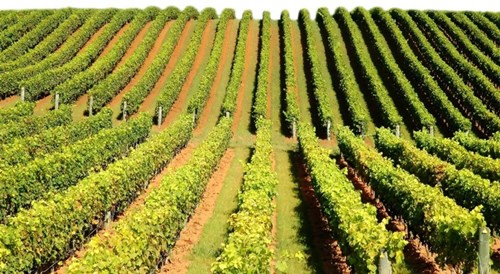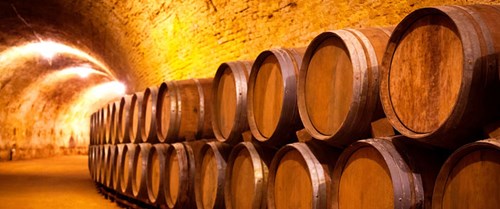Moldova is a small country favorably located in southeastern Europe. Lying near the Black Sea, where winemaking began, Moldova shares the same latitudes as some of the best winegrowing regions of France. Although its climate is more like that of Burgundy, its latitudes are similar to those of Bordeaux, between 46° and 48°. The countryside is characterized by rolling green hills and valleys. Grapes have been grown and made into wine in this region for thousands of years, and thus wine holds a special place in local culture. Moldovans like to point out that theirs is the only country with a shape that resembles a bunch of grapes.

The wine industry plays a significant role in the Moldovan economy. Moldova is highly dependent on wine and it is considered the backbone of the agricultural sector. It receives considerable attention from Moldovan authorities, who see it as a strategic sector since 90-95% of the wine is exported.
There are several types of wineries in Moldova that specialize in producing still wines, sparkling wines, and spirits. Approximately 40 wineries produce and export bottled wines. In global terms, Moldova was ranked 7th in the list of world wine exporters in 2011, exporting nearly 3 million hectoliters of bottled wine to more than 30 countries around the world.
Grape growing and winemaking in the territory of Moldova began 4,000 to 5,000 years ago when the Dacian people discovered how to make wine from grapes. Winemaking intensified when Greek settlers, who had arrived on the Black Sea coast by end of the 3rd century BC, brought with them their own winemaking traditions and shared them with the local people. Under the prosperous times of Roman Empire rule over this territory around 100 A.D., winemaking intensified.
With the foundation of the Moldovan feudal state in the 14th century, grape growing developed rapidly. It flourished in the 15th century during the rule of Stefan cel Mare (Stephen the Great) who imported new grape varieties and stimulated production of quality wine by creating the position of paharnic (cup bearer) who's task was to oversee the vineyards and winemakers to ensure high quality of wine production. His rule also provided an additional impulse in winemaking by increasing the area under cultivation with wine grapes, improving technology, and establishing household wine cellars.
In the early 16th century, the territory came under the control of the Ottoman Empire, which forbade winemaking. Thus, during the 300 years that followed, winemaking suffered major declines.
However, wine's fortune was reborn after the Treaty of Bucharest in 1812 when the region became a province of the Russian Empire. Russian nobility acquired wine estates and began to cultivate mostly local varieties such as Rara Neagră, Plavai, Galbena, Zghiharda, Batuta Neagră, Feteasca Albă, Feteasca Neagră, and others. The second half of the 19th century saw the importation of French vines and winemakers — the reason why Moldova has so many noble grape varieties today. It was also during this period that the famous zones in Moldova such as Purcari were established. The industry flourished, and by 1837 Moldova was producing more than 10 million liters per year.
Unfortunately, another setback for winemaking occurred at the end of the 19th century when a phyloxera outbreak killed many grape vines. However, by 1906 the vineyards had recovered with grafted planting material, and by 1914 Bessarabia (the territory of modern day Moldova between the Prut and Nistru Rivers) had the largest number of vineyards in the Russian Empire.
The First and Second World Wars took their toll on the region's vineyards; many were damaged and winemaking suffered. Not until World War II ended did Moldovan vineyards begin to recover. And recover they did; thanks to a major replanting effort in the 1950s, by 1960 the total cultivated vineyard area had reached 220,000 hectares. During the twenty years that followed, Moldova was the main wine producing republic in the USSR. Every second bottle of wine and every third bottle of sparkling wine was produced in Moldova.
In the mid-1980s, the Moldovan wine industry was hit hard again, this time by alcohol prohibition instituted by USSR head of state Mikhail Gorbachev. Vines were grubbed up on a massive scale and wine was destroyed. For Moldova, it was a national tragedy.
After Moldova became independent from the Soviet Union in 1991, the wine industry started its slow and difficult recovery. By mid-1990s most of the wineries were privatized and new owners began to invest in modern equipment. Significant investments in vineyards occurred from 2000 to 2005 when many wineries decided to plant European clones of popular varieties. Many vine nurseries were also established during this period, selling local rootstock in combination with European planting material.
In recent years, the industry continues to advance and evolve. Many wineries have started to work with winemakers from major wine producing countries such as Italy, France, Australia and New Zealand. They work alongside local vintners, transferring their knowledge of modern winemaking practices, including those required to produce young, fruit-forward wines which have become popular around the world. Moldovan winemakers have been quick to adopt these practices and to blend them with traditional wine styles to produce wines that are characteristic of Moldova.
Today, you can find Moldovan wine in many countries in Europe, North America, and Asia, and in Moldova's traditional markets of Russia and its former republics which historically consumed more than 90 percent of all Moldovan wine exports. A temporary embargo of Moldovan wine exports to Russia in 2006—2007 was a significant setback for the industry and many millions of dollars were lost. However it has sparked a renewed commitment to quality production, modernization, and market diversification that has translated into new investments in vineyards, plant and equipment, and winemaking. Today, Moldovan wine is better than ever.



